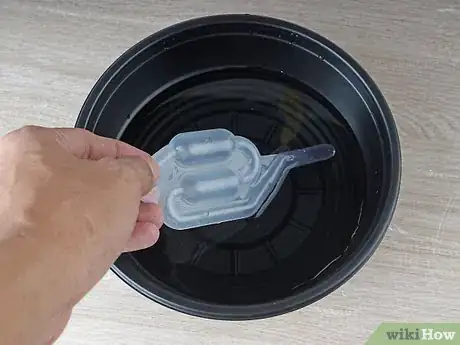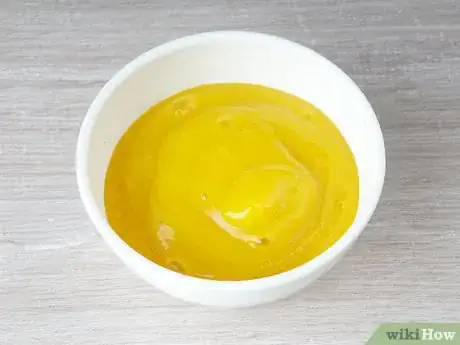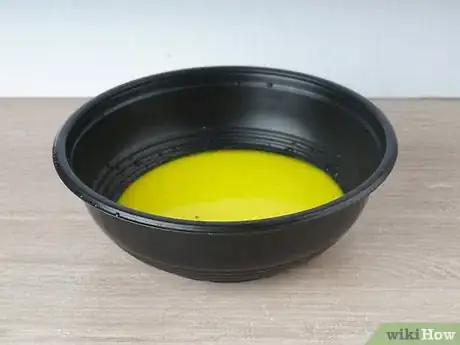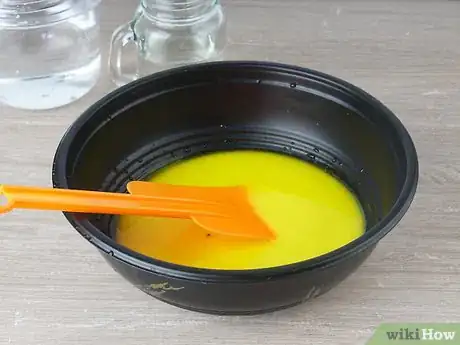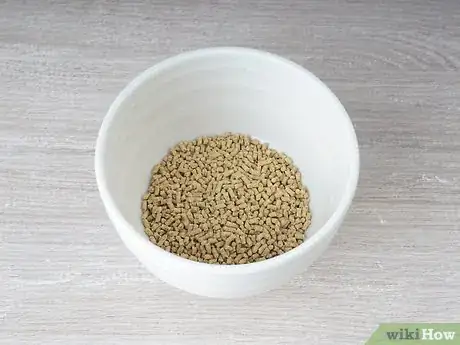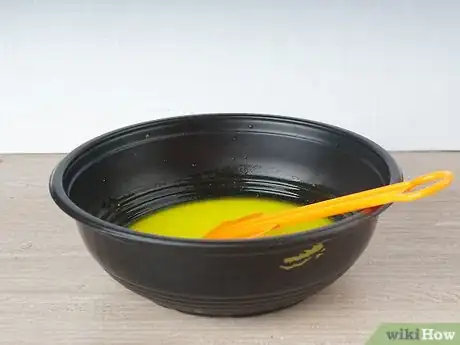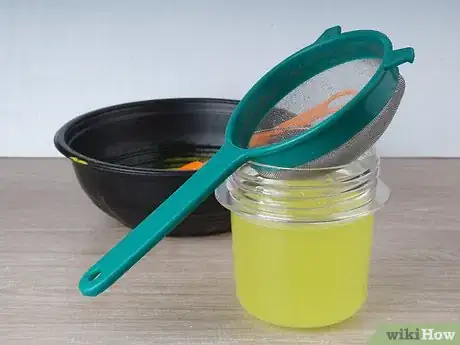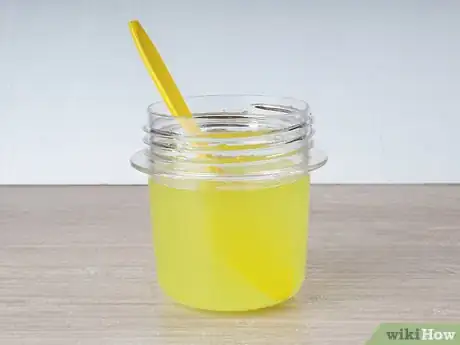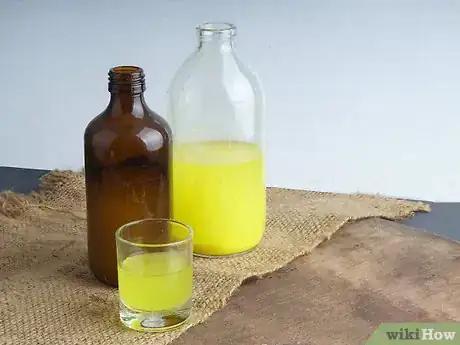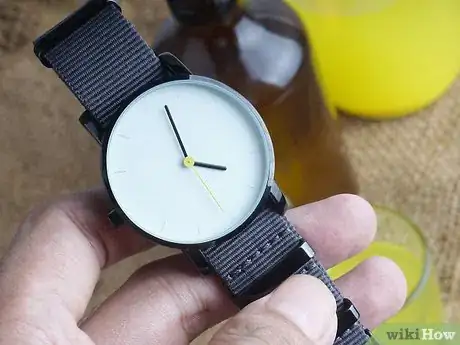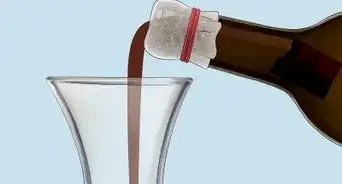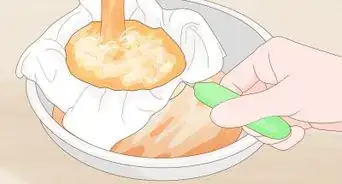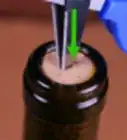This article was co-authored by wikiHow staff writer, Jessica Gibson. Jessica Gibson is a Writer and Editor who's been with wikiHow since 2014. After completing a year of art studies at the Emily Carr University in Vancouver, she graduated from Columbia College with a BA in History. Jessica also completed an MA in History from The University of Oregon in 2013.
This article has been viewed 32,077 times.
Learn more...
If you enjoy traditional wines but want to make your own sweet wine, make mango wine. Mangoes are naturally sweet, delicate in flavor, and they make a great base for wine. Use mango pulp, water, yeast, and sugar to create a must that ferments. Rack (transfer) and ferment the wine for several months so the wine becomes sweet and clear. Once the mango wine is flavorful and free from sediment, you can bottle it and store it for up to five years.
Ingredients
- 4.5 pounds (2 kg) mango pulp
- 1 gallon (3.8 liters) water
- 1 tablespoon (7.5 g) pectinase
- 1 teaspoon (2.8 g) Lalvin EC1118 yeast
- 1 heaped teaspoon (5 g) Lallemand Fermaid (yeast nutrient)
- 7 1/2 cups (1.5 kg) sugar
- 1 Campden tablet
Makes about 5 liters (four to six 750 ml bottles)
Steps
Preparing Supplies and Ingredients
-
1Assemble and sterilize the winemaking equipment. Buy winemaking tools and equipment online or from a homebrewing and fermenting supplier. Wash all of the equipment and bottles before you start the winemaking process. Just use hot water and a scrub brush to sterilize the equipment. Don't use soap because it will leave a thin residue behind. Or you can sterilize the equipment by washing it in a bleach solution (1/4 cup or 60 ml of bleach for every gallon or 3.8 liters of water). You'll need:[1]
- One 2-gallon (7.6 L) glass jar or crock
- One long wooden spoon
- One 2-gallon (7.6 L) carboy or demijohn (a glass container with a small neck)
- One airlock
- One thin plastic tube for siphoning
- Four to six wine bottles with corks or screw caps
-
2Measure the mango pulp and boiling hot water over it. If you're using fresh mangoes, scrape out and squeeze the flesh of the fruit. You can also purchase mango pulp. You'll need to measure 4.5 pounds (2 kg) of mango pulp into a large pot. Bring a kettle of water to a boil and carefully pour 1 gallon of the hot water over the mango pulp.[2]
- If you're buying mango, ensure that sorbic acid (sorbate) hasn't been added since it can slow fermentation. It's alright if the mango contains sulfates.
Advertisement -
3Stir in the pectinase and let the mixture set for one day. Give the watered mango time to cool to room temperature. This could take about 30 minutes. Stir 1 tablespoon (7.5 g) of pectinase into a few tablespoons of the watered mango until it's dissolved. Stir the dissolved pectinase into the mango mixture. Cover the pot and leave the mixture to rest for 24 hours.[3]
-
4Dissolve some of the sugar and stir it into the mango mixture. Measure out 7 1/2 cups (1.5 kg) of sugar. Put 2 1/2 cups (500 g) of the sugar into a mixing bowl and set the rest of the sugar aside. Pour a little of the cooled mango mixture into the mixing bowl and stir it well. The sugar should dissolve.[4]
- Once you add the sugar, the mango mixture is called must. The must will ferment once you add the yeast and you'll strain the liquid to make mango wine.
Fermenting Mango Wine
-
1Activate the wine yeast and add it to the must. Place a few tablespoons (about 30 ml) of water into a small bowl. Stir in 1 teaspoon (2.8 g) of Lalvin EC1118 yeast and 1 heaping teaspoon (5 g) of Lallemand Fermaid A yeast nutrient. Stir until the yeasts are dissolved and add it to the must (the mango mixture).[5]
- Yeast nutrient will keep the yeast healthy during the fermentation process. It's especially important since mango wine has such a long fermentation period.
-
2Stir and rest the must for 5 to 7 days. Pour the mango must into the clean 2-gallon (7.6 L) glass jar and cover it. Put the bottle in a warm place around 6 to 70 degrees F (15 to 20 degrees C). Stir the must once a day and let it rest for 5 to 7 days. The must won't froth very much by the end of the resting period.[6]
- You can cover the container with a lid or cheesecloth. Wrap a rubber band around the cheesecloth to keep it in place and prevent bugs from getting into the must.
-
3Strain the mango must. The must will not be very bubbly or foamy once it's finished resting, so you can strain it at this point. Use a thin plastic tube to siphon the liquid into a 2-gallon (7.6 L) carboy or demijohn so the liquids are strained out. Secure an airlock onto the carboy or demijohn. The airlock will let gas escape and prevent oxygen from getting into the storage container.[7]
-
4Ferment the wine for several weeks or months and rack it. You should notice the must bubble and froth for a few weeks or even a few months. Once it seems like the must isn't fermenting as much and the bubbles die down, siphon the wine to a clean carboy or demijohn.[8]
- Siphoning the wine to a new container is known as racking. Racking will leave solids in the bottom of the old container, which will make the wine clearer.
-
5Stir in more sugar and ferment the wine for several more weeks or months. Dissolve another 2 1/2 cups (500 g) of sugar in a little of the must. Stir the dissolved mixture into the must and put the airlock back in. Let the wine ferment for several more weeks or months as long as it's bubbling or foaming.[9]
-
6Rack the wine and add more sugar. Once the fermentation stops, siphon the wine into another clean carboy or demijohn. Dissolve the last 2 1/2 cups (500 g) of sugar in a little of the must and stir it into the new container. Put the airlock in the container and leave it to ferment again.[10]
- The amount of time it takes to ferment your wine will depend on your fruit, the temperature, and the yeast. Keep an eye on it to watch for activity (bubbling, foaming, frothing).
Bottling and Serving Mango Wine
-
1Sample the mango wine. Once the mango wine has stopped fermenting, remove a sample from the carboy or demijohn. The mixture shouldn't be foaming or bubbly and it should be clear, not cloudy. Taste the wine to see if it's sweet enough for your taste. If it is, you can begin bottling it.[11]
- If you'd like the wine to be sweeter, you can dissolve more sugar in some of the liquid, return it to the mixture, and ferment it for another few weeks or months.
-
2Bottle the wine. If you're happy with how sweet and clear the mango wine is, you can siphon the wine into clean bottles. You'll need four to six 750-ml bottles. Use a thin plastic tube to siphon the wine from the carboy or demijohn into the bottles. Avoid filling the bottles completely full. There should be a few inches (about 5 cm) of space for the cork at the top.
- Try not to agitate or move the wine around too much as you siphon it. Movement could stir up the sediment and make the wine become cloudy again.
-
3Cork the wine. Dissolve one Campden tablet in a small glass of water and put your corks into it. Soak the corks for about 15 minutes. Remove the corks and insert them into the top of each filled bottle. You'll need to push down on each cork using the force of your shoulders.
- Soaking the cork in a Campden mixture will sterilize the corks. It will also make it easier to push the corks into the bottles.
-
4Rest the mango wine for about a year. Give the mango wine a chance to age so flavors can develop. Set the wine aside and drink it six months to one year after you bottle it. Keep in mind that mango wine should be used within 3 and 5 years of bottling.[12]
Things You'll Need
- Measuring cups and spoons
- Digital scale
- 2-gallon (7.6 L) glass jar or crock
- Long wooden spoon
- 2-gallon (7.6 L) carboy or demijohn (a glass container with a small neck)
- Airlock
- Thin plastic tube for siphoning
- 4-6 750-ml wine bottles with corks or screw caps
- Large pot with a lid
References
- ↑ http://extension.uga.edu/publications/detail.html?number=C717
- ↑ http://winemakersacademy.com/kerrys-magnificent-mango-wine-recipe/
- ↑ http://winemakersacademy.com/kerrys-magnificent-mango-wine-recipe/
- ↑ http://winemakersacademy.com/kerrys-magnificent-mango-wine-recipe/
- ↑ http://winemakersacademy.com/kerrys-magnificent-mango-wine-recipe/
- ↑ http://winemakersacademy.com/kerrys-magnificent-mango-wine-recipe/
- ↑ http://winemakersacademy.com/kerrys-magnificent-mango-wine-recipe/
- ↑ http://winemakersacademy.com/kerrys-magnificent-mango-wine-recipe/
- ↑ http://winemakersacademy.com/kerrys-magnificent-mango-wine-recipe/
